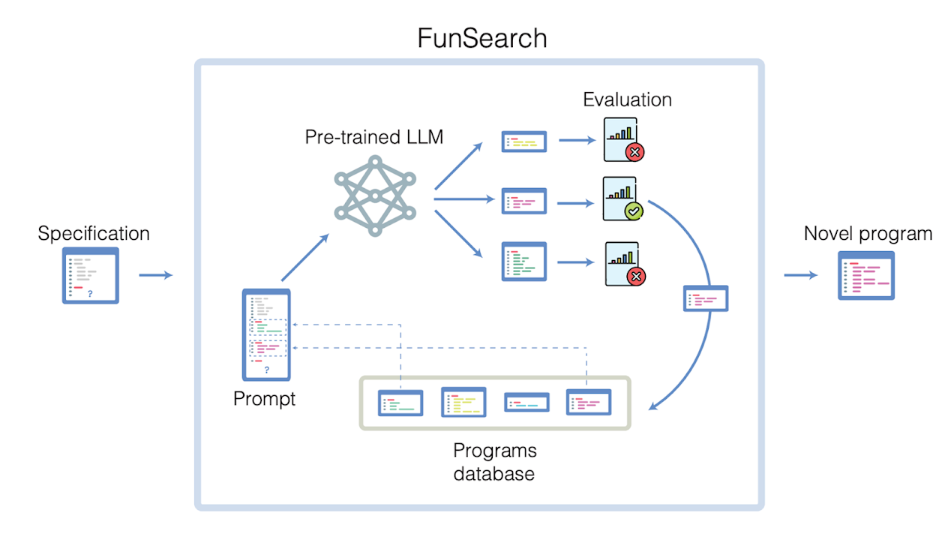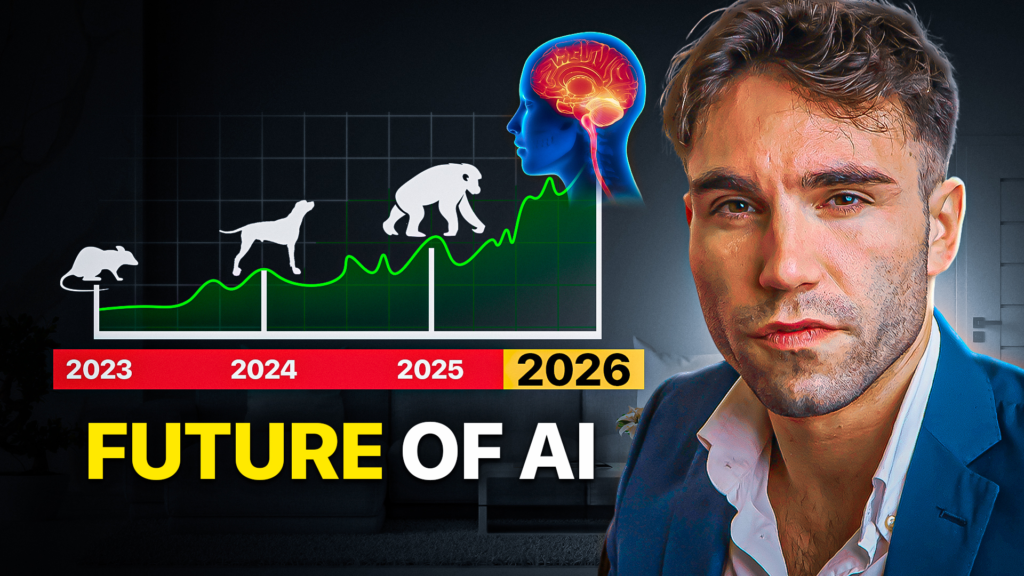FunSearch, a newly unveiled GenerativeAI-based architecture by DeepMind, is revolutionizing the realm of mathematical sciences. Representing a significant advancement in our capacity to tackle complex challenges, this innovative tool’s potential reaches far beyond the academic sphere.
In this blog post, we will delve into:
- How FunSearch operates, utilizing a unique blend of generative AI and evolutionary algorithms to generate and refine solutions continuously,
- The potential of FunSearch for diverse business applications
- 5 key business applications of the FunSearch concept, including Investment Portfolio Optimization, Cosmetics Routine Development, Business Strategy and Market Analysis, and Material Development and Proposal in B2B sectors”
How FunSearch operates
FunSearch operates by harnessing the capabilities of Large Language Models (LLMs) to generate and evolve computer programs as solutions to complex problems. The choice of computer programs as output is strategic; programs are not only precise in their execution but also highly interpretable, allowing for the clear understanding and verification of the solutions provided.
Computer programs embody a form of output that can be directly executed, tested, and integrated into existing systems, making them particularly practical. Additionally, because programs can encapsulate complex logic and behavior in a structured and modular way, they lend themselves to iterative improvement and refinement — core principles of the FunSearch process. This iterative nature of program generation enables FunSearch to progressively evolve more efficient and innovative solutions.
Components of FunSearch’s Architecture:
- LLM (Pre-trained Large Language Model): AI model trained on extensive datasets, including coding languages, enabling them to generate a range of potential solutions in the form of programs.
- Seed Programs: Initial programs or solutions that serve as the starting point for the evolutionary process. They are related to the specific problem being addressed.
- Program Pool: A collection of programs, including seed programs and those generated by the LLM, which form the basis for iterative improvement.
- Program Evaluation Procedure: A system to automatically execute and evaluate the effectiveness of the programs generated by the LLM. This procedure assesses programs based on predefined criteria relevant to the problem.
- Selection Mechanism: A method to select the best-performing programs from the evaluation process for further iteration.
- Feedback Loop: The mechanism through which selected programs are fed back into the LLM for further development and refinement.

Flow of the FunSearch System:
- Initialization: The process starts with seed programs, which are fed into the program pool.
- Generation of New Programs: The LLM takes programs from the pool and generates new variations or entirely new programs based on its training and the input provided.
- Execution and Evaluation: These new programs are then automatically executed and evaluated for their effectiveness in solving the problem.
- Selection and Feedback: The best-performing programs from this evaluation are selected and fed back into the program pool.
- Iterative Improvement: This cycle of generation, evaluation, selection, and feedback is repeated, with each iteration aiming to produce more effective and refined solutions than the previous one.
- Output of Refined Programs: Over time, the system iteratively improves upon the initial seed programs, leading to more efficient, innovative, and effective solutions. These outputs are designed to be concise and interpretable
The potential of FunSearch in business
The approach of framing problems as computer programs, as utilized by FunSearch, holds significant promise for diverse business applications. In fields like material science, cosmetics, engineering, business strategy, finance, supply chain management, the method can yield algorithms that predict new materials with desired properties, or can produce personalized product recommendations or formulations, enhancing customer satisfaction and loyalty, or generate models that simulate market conditions and consumer behavior, offering actionable insights for decision-making. In engineering, computer programs can optimize design parameters for efficiency, sustainability, or cost-effectiveness.
Essentially, by framing problems as programs, businesses can leverage the same concept to automate and optimize complex decision-making processes, drive innovation, and maintain a competitive edge in their respective industries.
Expanding on FunSearch’s concept
The architecture doesn’t need to be limited to generating computer programs. It can be adapted to output structured solutions in various forms — be it bullet points for strategic planning, Excel files for financial analysis, or even qualitative descriptions for marketing content — while maintaining the architecture’s core functionality.
This flexibility enables the LLM to tailor its output to the context and user requirements, providing solutions that are immediately useful and easily interpretable. Whether it’s providing a step-by-step guide for business process improvement or an itemized list of resource allocations, the structured output can fit seamlessly into the workflows of different business units.
Moreover, the same architecture upholds the positive iteration loop, crucial for both lifelong learning when the system is active and for honing the best possible solutions during problem-solving sessions. This iterative process allows the system to learn from feedback, adapt to new data, and refine its outputs continually — whether live in dynamic environments or in a developmental phase to solve a static problem. This adaptability of FunSearch’s architecture makes it a potent tool for businesses looking to innovate and evolve their problem-solving approaches.
Business Applications
Investment Portfolio Optimization
In the context of Investment Portfolio Optimization, applying FunSearch’s architecture could dramatically transform the financial sector’s approach to managing and optimizing investments. Here’s how this could work qualitatively:
- Data Analysis: The LLM would begin by ingesting vast amounts of financial data, including market trends, historical performance metrics, and real-time economic indicators.
- Strategy Generation: Instead of computer programs, the LLM could output structured investment strategies. These could take the form of prioritized bullet points, spreadsheets with asset allocations, or decision trees that map out investment moves under various market conditions.
- Iterative Optimization: As with FunSearch, each proposed strategy would be evaluated based on historical data and simulated outcomes. The most promising strategies would then be fed back into the system, creating a loop of continuous refinement.
- Adaptability: The system would be designed to adapt to new data and shifting market conditions, learning from both successful outcomes and market volatility. This would enable the identification of robust investment opportunities and the mitigation of risks.
- Output Integration: The structured outputs would be in formats readily integrated into financial analysts’ workflows, such as detailed reports or dashboards that provide at-a-glance actionable insights.
Cosmetics Routine Development
Applying the FunSearch-inspired architecture to Cosmetics Routine Development in retail could lead to a highly personalized and dynamic customer experience. Here’s a qualitative exploration of how this might unfold:
- Customer Data Analysis: The LLM would analyze detailed customer data, including skin type, beauty preferences, past purchase history, and even environmental factors that could affect skin health.
- Personalized Routine Creation: Utilizing this data, the LLM generates personalized skincare or makeup routines. These could be presented as step-by-step guides, visual routines in a mobile app, or customized shopping lists, crafted to match each customer’s unique needs.
- Iterative Learning: Customer feedback on product effectiveness and satisfaction would be incorporated into the model, enabling the LLM to refine its recommendations. This feedback loop ensures that the AI continually learns from real-world outcomes and preferences, enhancing its accuracy over time.
- Market Adaptation: As new products enter the market or as beauty trends evolve, the LLM adapts its recommendations, ensuring customers have access to the latest and most suitable cosmetic solutions.
- Solution Integration: The structured solutions provided by the AI could be integrated into a retailer’s CRM system, enabling sales associates to offer personalized advice or into an e-commerce platform for tailored online shopping experiences.
Business Strategy and Market Analysis
Adapting the FunSearch architecture for Business Strategy and Market Analysis involves creating a system that can process complex market data to inform strategic decisions. Here’s how it could qualitatively enhance strategic planning and market analysis:
- Market Data Assimilation: The system would absorb extensive datasets, encompassing market trends, consumer behavior analytics, competitive landscape, and economic indicators.
- Strategic Proposal Generation: Instead of computer programs, the LLM would generate strategic proposals. These could manifest as detailed reports, actionable bullet points, or visual data representations, such as graphs and heat maps that highlight market opportunities and threats.
- Iterative Refinement: Each strategy would be evaluated against current and historical market performance, possibly using simulations to predict future market states. Effective strategies would be refined and re-evaluated in a continuous improvement loop.
- Responsiveness to Change: As the market evolves, the system would ingest new data, ensuring that strategic recommendations remain relevant. This adaptability is key for responding to sudden market shifts, like new regulations or emerging technologies.
- Deployment of Insights: The insights would be structured in a way that facilitates easy incorporation into business decision-making processes, with summaries for executives and detailed analyses for operational teams.
Material Development and Proposal in B2B
The FunSearch architecture, when applied to Material Development and Proposal in B2B, could significantly innovate the way companies discover and enhance materials. Here’s a deep dive into how this could work in a qualitative sense:
- Data Integration: The system would start by ingesting extensive data on material properties, processing methods, historical performance, and application requirements. This data serves as the foundation for generating new material proposals.
- Simulation and Prediction: Using this data, the LLM could simulate a wide range of material compositions and processing methods, predicting outcomes and properties such as strength, durability, and cost-efficiency.
- Iterative Material Evolution: The outcomes of these simulations would be assessed for their potential market impact and feasibility. The best-performing material proposals, those that meet or exceed specific criteria, would be retained and used as a basis for further iterations, leading to a cycle of continuous improvement.
- Customization for B2B Needs: For B2B applications, the system can tailor its output to specific industry needs — whether that’s generating a technical datasheet, a visual representation of material stress tests, or a cost-benefit analysis for manufacturing.
- Sustainability and Efficiency: The architecture’s capability to iterate rapidly allows for the exploration of materials that could be more sustainable or efficient to produce, addressing environmental concerns and potentially reducing costs.
- Integration into R&D Cycles: The iterative proposals can be integrated directly into R&D cycles, accelerating the pace of material innovation and development, and enabling companies to bring novel materials to market more quickly.
Engineering Project Development
In the field of Engineering Project Development, applying the FunSearch architecture could bring about transformative improvements in the design and execution of complex projects. Here’s a qualitative examination of its application:
- Project Parameter Analysis: The LLM would initially ingest detailed specifications of the engineering project, including constraints, objectives, and available resources. This could encompass material properties, structural requirements, budgetary limitations, and environmental impact considerations.
- Solution Evolution: Based on this input, the LLM generates multiple engineering solutions — ranging from material selection to structural designs and resource allocation plans. These solutions could be in the form of detailed engineering drawings, CAD models, or project management plans.
- Iterative Refinement: Each generated solution is evaluated for its feasibility, efficiency, and cost-effectiveness against a set of performance metrics. The most promising solutions are then evolved further, enhancing their design or suggesting alternative materials or construction methods.
- Adaptation and Optimization: As the project progresses, the system adapts to new data, such as changes in material costs or updated construction regulations, ensuring that the project remains on the cutting edge of efficiency and innovation.
- Integration and Collaboration: The outputs of this process are integrated into collaborative tools used by engineering teams, enabling seamless sharing and iteration across different departments and stakeholders.
- Continuous Improvement: The architecture fosters a cycle of continuous improvement, where project designs are not static but evolve as new information becomes available, leading to designs that are both innovative and responsive to real-world challenges and opportunities.
In each of these applications, FunSearch’s architecture is revolutionary because it combines the creative problem-solving capabilities of LLMs with a systematic, iterative, and evolutionary approach. This leads to solutions that are not only effective and innovative but also adaptable and interpretable, aligning well with the complex and rapidly changing nature of modern business challenges.



